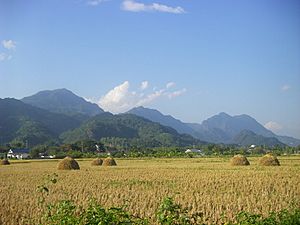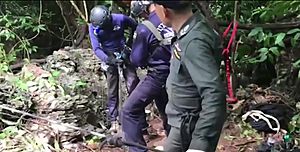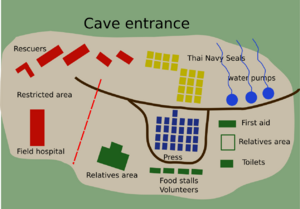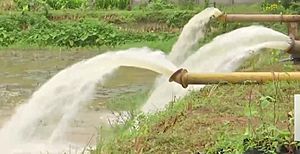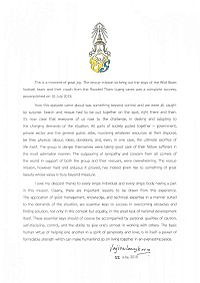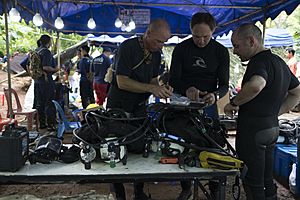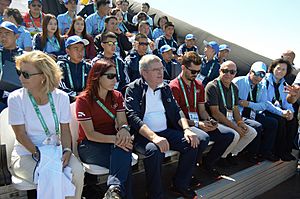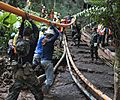Tham Luang cave rescue facts for kids

Rescue personnel and equipment at the cave entrance
|
|
| Date | 23 June – 10 July 2018 (18 days) |
|---|---|
| Location | Tham Luang Nang Non cave, Mae Sai, Chiang Rai Province, Thailand |
| Coordinates | 20°22′54″N 99°52′06″E / 20.38167°N 99.86833°E |
| Type | Cave rescue |
| Cause | Monsoon flooding |
| Outcome | Group found alive on 2 July; all rescued between 8 and 10 July 2018. |
| Deaths | 2 rescuers (including 1 later which resulted from the rescue) |
| Non-fatal injuries | Minor scrapes and cuts, mild rashes, lung inflammation |
In June and July 2018, a junior football team and their assistant coach were rescued from the Tham Luang Nang Non cave in northern Thailand. Twelve boys, aged 11 to 16, and their 25-year-old assistant coach entered the cave on June 23 after football practice. Soon after, heavy rain caused the cave to flood, blocking their way out. This trapped them deep inside.
Finding the group was very hard because of rising water and strong currents. No one heard from them for over a week. The cave rescue grew into a huge operation. It involved rescue teams from many countries and caught worldwide attention. On July 2, British divers John Volanthen and Rick Stanton found the group alive. They were on a high rock about 4 kilometres (2.5 mi) (2.5 miles) from the cave entrance.
Rescue leaders thought about different ways to get the group out. They considered teaching them basic underwater diving skills. Another idea was to find or drill a new entrance to the cave. They also thought about waiting for the floodwaters to go down, which could take months. After days of pumping water out and a break from the rain, rescuers hurried to get the group out. More monsoon rain was expected around July 11.
Between July 8 and 10, all 12 boys and their coach were rescued. An international team worked together to bring them to safety.
The rescue involved about 10,000 people. This included over 100 divers and many rescue workers. Around 100 government groups, 900 police officers, and 2,000 soldiers helped. Ten police helicopters, seven ambulances, and over 700 diving tanks were used. More than one billion liters of water were pumped from the caves.
Saman Kunan, a 37-year-old former Thai Navy SEAL, died on July 6. He ran out of oxygen while returning from delivering diving tanks to the trapped group. The next year, in December 2019, another rescue diver, Thai Navy SEAL Beirut Pakbara, died. He got a serious blood infection during the operation.
Contents
The Missing Team and the Cave
The Tham Luang Nang Non cave is a system of caves under Doi Nang Non mountain. This mountain is on the border between Thailand and Myanmar. The cave system is about 10 kilometres (6.2 mi) (6 miles) long. It has many deep areas, narrow paths, and tunnels under hundreds of meters of rock. Parts of the cave flood during the rainy season. A sign at the entrance warns people not to enter between July and November.
On Saturday, June 23, 2018, a group of twelve boys went missing. They were from a local junior football team called the Wild Boars. The boys, aged 11 to 16, and their 25-year-old assistant coach, Ekkaphon Chanthawong, went to explore the cave. They got stuck inside because of sudden and heavy rainfall. The rising water blocked their way out.
Around 7 p.m., the head coach, Nopparat Kanthawong, saw many missed calls from worried parents. He called the assistant coach and the boys, but no one answered. Finally, he reached Songpon Kanthawong, a 13-year-old team member. Songpon said he had been picked up after practice, and the others went to the Tham Luang caves. The coach rushed to the cave and found their bicycles and bags near the entrance. Water was flowing out of the muddy path. He quickly told the authorities about the missing group.
Meet the Team Members
The trapped team members were:
| Name (RTGS) | Nickname | Age | Notes |
|---|---|---|---|
| Chanin Wibunrungrueang | Titan | 11 | |
| Phanumat Saengdi | Mig | 13 | |
| Duangphet Phromthep | Dom | 13 | Team captain. |
| Somphong Chaiwong | Pong | 13 | |
| Mongkhon Bunpiam | Mark | 13 | Last one rescued. |
| Natthawut Thakhamsong | Tern | 14 | Rescued in the first group. |
| Ekkarat Wongsukchan | Bew | 14 | |
| Adun Sam-on | Dul | 14 | The only one who spoke English; he talked to the first rescuers. |
| Prachak Sutham | Note | 15 | Rescued in the first group. |
| Phiphat Phothi | Nick | 15 | Rescued in the first group. |
| Phonchai Khamluang | Tee | 16 | |
| Phiraphat Somphiangchai | Night | 16–17 | Celebrated his birthday while in the cave. |
| Ekkaphon Kanthawong | Eak | 25 | Assistant coach and former monk. Ninth one rescued. |
The assistant coach and three of the boys did not have a nationality. This meant they were "stateless." They were from tribes in an area where the borders of Thailand, Myanmar, Laos, and China meet. People in this region often do not have passports. Not having a nationality meant they couldn't travel easily or get basic benefits. The team's founder, Nopparat Khanthavong, said getting nationality was their biggest hope. After the rescue, Thai officials promised to help them get Thai citizenship. On September 26, the three boys and the coach were granted Thai citizenship.
The Search Begins
Vern Unsworth, a British cave expert living in Chiang Rai, knows the cave well. He was planning to go into the cave on June 24 when he heard about the missing boys. He told the Thai government to ask for help from the British Cave Rescue Council (BCRC). On June 25, Thai Navy SEALs divers arrived and started searching. The water was so muddy that even with lights, they could not see anything underwater. Heavy rain made the entrance flood more, stopping the search for a while.
On June 27, three BCRC cave divers arrived with special gear. They had radios that work in caves. Other diving teams followed. On June 28, a US Air Force team joined them. By June 29, divers from Australia and China had also arrived.
Meanwhile, police with sniffer dogs searched the mountain above the cave. They looked for other openings that might lead into the cave system. Drones and robots were also used, but no technology could scan for people deep underground.
British divers Richard Stanton and John Volanthen led the search deep into the cave. They placed guide lines to help others navigate. Other divers from Belgium and France supported them. The search was stopped again because of heavy rain. The rain made the water flow faster and visibility worse. The search started again on July 2 when the weather got better.
Finding the Team
The twelve boys and their coach were found around 10:00 p.m. on July 2. Divers Stanton and Volanthen found them. The boys and coach were on a narrow rock shelf. This spot was about 400 metres (1,300 ft) (1,300 feet) past a chamber called "Pattaya Beach." Volanthen was placing guide lines when he ran out of line. He swam to the surface and soon found the group. He smelled them before he saw or heard them! The ledge where they were found is about 4 kilometres (2.5 mi) (2.5 miles) from the cave entrance.
A video of the moment was shared by the Thai Navy SEALs. It showed the boys talking with the divers. The former governor of Chiang Rai, Narongsak Osatanakorn, who was in charge of the rescue, said, "We found them safe. But the operation isn't over." Thai, US, Australian, and Chinese diving teams helped bring diving tanks into the cave. They set up a place to store air tanks in Chamber 3.
On July 3, three Thai Navy SEALs joined the trapped group. They stayed with them until the rescue. One of them was Thai Army doctor Lt. Col. Pak Loharachun. Thai officials said rescuers were checking the boys' health and keeping them entertained. None of them were in serious condition. They were given easy-to-digest, high-energy food with vitamins. A video shared by the Thai Navy SEALs showed all twelve boys and their coach introducing themselves. They looked tired but said hello to the outside world. They all said "Sawatdi khrap" (hello) with their palms together in a traditional Thai greeting.
It was thought that some of the group could not swim. This made the rescue even harder. The Army doctor found that the team had tried to dig their way out. They used rocks to dig every day, making a hole five meters deep. Diver Jason Mallinson let the boys and coach send messages to their families using his waterproof notepad. Many notes said they were safe and sent love to their families.
Planning the Rescue
A large camp was set up at the cave entrance. It had hundreds of volunteers, journalists, and rescue workers. The area was divided into different zones. There were restricted areas for military and rescuers, a private area for families, and areas for the press and public.
About 10,000 people helped with the rescue. This included over 100 divers, 900 police officers, and 2,000 soldiers. Ten police helicopters, seven ambulances, and over 700 diving tanks were used. More than a billion liters of water were pumped out of the caves.
Challenges Inside the Cave
The boys were trapped about 4 kilometres (2.5 mi) (2.5 miles) from the entrance. They were also 800–1,000 metres (2,600–3,300 ft) (2,600–3,300 feet) below the mountain top. The path to them had flooded parts with strong currents and no visibility. Some parts were extremely narrow, as small as 38 by 72 centimetres (15 in × 28 in) (15 x 28 inches).
Even for experienced divers, the trip to the boys took six hours against the current. The trip out took five hours with the current.
Rescuers fought against rising water levels from the start. They built a dam upstream and installed pumps to remove water from the cave. On July 4, pumps were removing about 1,600,000 L/h (420,000 US gal/h) (420,000 gallons per hour). This flooded nearby farm fields. For a while, some volunteers accidentally pumped water back into the ground. Luckily, a period of dry weather helped. Water levels dropped by 1.5 centimetres (0.59 in) (0.6 inches) per hour on July 5. This allowed rescue teams to walk 1.5 kilometres (0.93 mi) (0.9 miles) into the cave. However, heavy rains were expected on July 8. These rains could stop or reverse the progress. They could even flood the area where the team was trapped.
On July 6, the oxygen level in the cave dropped. This worried rescuers that the boys might not get enough oxygen if they stayed too long. By July 8, the oxygen level was 15%. Normal levels for humans are between 19.5% and 23.5%. Thai military engineers tried to install an air supply line to the boys, but it was too difficult.
Rescue Options
As the situation developed, rescuers considered several ways to save the team:
- Wait: They could wait until the end of the monsoon season. Divers would bring food and water to the group.
- Teach Diving: They could teach the group basic diving skills.
- Find New Entrance: They could find another way into the cave. One shaft was found that went down 900 meters (3,000 feet).
- Drill Shaft: They could drill a rescue shaft. More than 100 holes were drilled into the soft rock, but no good spot was found.
- Oxygen Line: Build a line to supply oxygen.
- Telephone Wire: Build a telephone wire for communication.
The Diving Plan
The dangers of more heavy rain, dropping oxygen levels, and the difficulty of finding other exits forced rescuers to act. They decided to bring the team out with experienced divers. Thai Navy SEALs and US Air Force experts met with the Thai Minister of the Interior. The plan was approved. Ninety divers worked in the cave: forty from Thailand and fifty from other countries.
At first, rescuers thought about teaching the boys basic diving skills. They even built a practice area with chairs to look like a tight passage. Divers practiced with local boys in a school swimming pool. But then, Thai SEALs and US Air Force experts changed the plan. They decided to use teams of divers to bring out the weakened boys.
The Rescue Operation
On the morning of July 8, officials told media and other people to leave the cave entrance area. A rescue operation was about to begin. More monsoon rains were expected later in the week, which could flood the cave until October.
For the first part of the rescue, 18 divers went into the caves. This included 13 international cave divers and five Thai Navy SEALs. One diver went with each boy. There were different ideas about who would be rescued first. In the end, the boys who volunteered first were chosen. The coach, Ekapol Chanthawong, said everyone was strong and mentally ready. The team decided that the boys who lived the farthest away should leave first. They thought they would need to ride their bikes home and wanted to tell everyone they were okay.
The international diving team was led by four British divers: John Volanthen, Richard Stanton, Jason Mallinson, and Chris Jewell. Two Australians, Dr. Richard Harris (a doctor who specializes in anesthesia) and Craig Challen, also played key roles. An Irish diver, Jim Warny, helped on the last day to bring out the coach. These lead divers swam over 1 kilometer (0.6 miles) through flooded paths. They were supported by 90 other divers who checked on them and refilled their air tanks.
The boys wore wetsuits, life jackets, and full-face diving masks. An oxygen tank was clipped to their front. A handle was on their back, and they were tied to a diver so they wouldn't get lost in the poor visibility. Rescuers called them "a package." Dr. Harris gave the boys medicine to make them unconscious before the journey. This was to stop them from panicking, which could put their lives and the rescuers' lives at risk. They also received medicine to help with anxiety and steady their heart rates. The Thai government gave Dr. Harris and two medical helpers special protection in case anything went wrong.
The medicine lasted about 45 minutes to an hour. Divers, trained by Dr. Harris, gave "top-up" injections during the three-hour journey. Divers guided the boys through the water, holding onto their back or chest. In very narrow spots, divers pushed the boys from behind. They were careful not to let the boys' masks hit rocks. Divers kept their heads higher than the boys so they would hit rocks first in poor visibility. After a short dive to a dry section, the boys' dive gear was removed. They were then carried on a stretcher over 200 meters (650 feet) of rocks and sand. Dr. Challen checked them, and their gear was put back on for the next section. The boys arrived about 45 minutes apart. Divers knew the boys were breathing from the bubbles they could see and feel.
After being brought to Chamber 3 by divers, the boys were passed along a "daisy chain" of hundreds of rescuers. They were wrapped in special stretchers and carried, slid, or zip-lined using a system of pulleys. Many areas from Chamber 3 to the entrance were still partly underwater. Rescuers had to carry the boys over slippery rocks and through muddy water for hours. The trip from Chamber 3 to the entrance took about four to five hours at first. But it was reduced to less than an hour after a week of draining water and clearing the path.
Authorities warned that getting everyone out would take several days. Crews needed to replace air tanks and supplies, which took ten to twenty hours between each rescue run. Shortly after 7:00 p.m., officials said two boys had been rescued and taken to the hospital. Soon after, two more boys came out. Lower water levels helped speed up the rescues. This was thanks to better weather and a dam built outside the cave to control the water.
On July 9, four more boys were rescued. On July 10, the last four boys and their coach were rescued. Experience helped make the rescue faster. The time to get a boy out dropped from three hours on the first day to just over two hours on the last day. This allowed four boys and the coach to be rescued. The three Thai Navy SEALs and the Army doctor who stayed with the boys were the last to dive out. Three of these divers reached Chamber 3. Then, the pumps suddenly stopped working, possibly due to a burst pipe. Water levels in Chamber 3 started to rise quickly. This would have cut off rescuers' way out. Rescuers had to rush to the cave exit, leaving equipment behind. They made it out in under an hour.
News reports highlighted the role of coach Ekkaphon. He had been a Buddhist monk and guided the children in meditation during their time in the cave. He also sent a message apologizing for putting the children in danger.
Recovery and Health
Thai authorities said the rescued boys could eat rice porridge. More complex foods would be held back for ten days. The Thai Health Ministry said the boys lost about 2 kilograms (4.4 lb) (4.4 pounds) each but were in "good condition." The boys were kept separate from others while health workers checked for infections. They were expected to stay in the hospital for at least a week. Because they were in the damp cave for so long, officials worried about infections like histoplasmosis or leptospirosis. Parents could visit through a window at first. If tests were negative, they could visit in person while wearing medical gowns and masks.
The boys wore sunglasses to help their eyes adjust to daylight. Doctors did detailed tests on their eyes, nutrition, mental health, and blood. A Health Ministry doctor said all the boys had an increase in white blood cells. So, they were all given antibiotics to prevent infection.
How People Responded
Local Support
People in Chiang Rai province volunteered to cook and clean for the families and rescue teams at the cave. Social media helped spread the word about the rescue. Classmates and teachers of the team prayed for the boys. Classmates of one boy made 1,000 paper cranes, praying for his safe return. Local schools donated money to help parents with living costs, as many stopped working to follow the rescue.
On June 29, Prime Minister Prayut Chan-o-cha visited the site. He told the families not to give up hope. After Saman Kunan died, King Vajiralongkorn said he would pay for Kunan's funeral.
After the rescue, the boys' families, rescue leaders, military officials, and volunteers gathered at the cave entrance. They gave thanks for the lives saved. They also asked for forgiveness from the cave goddess "Jao Mae Tham" for all the equipment and people in the cave during the rescue.
Opinions About the Coach
Some people, mainly in Western news, wondered if assistant coach Ekkaphon Chanthawong should be blamed for taking the group into the caves. There was a warning sign at the entrance about entering between July and November. The boys entered on June 23.
However, local communities and the boys' parents said they did not blame the boys or their coach. The rain had come a month earlier than usual. Vern Unsworth, the British cave expert, said, "Nobody's to blame, not the coach, not the boys. They were just very unlucky." He explained that the mountain acts like a sponge, and earlier rains had already raised water levels.
While police considered if the coach was careless, no legal action was taken against him. Many lawyers said he likely wouldn't face charges because Thai law looks at whether someone meant to cause harm. In the news, Ekkaphon was widely called "a hero." He was a "calm voice [that] helped boys to beat despair in the darkness." The coach reportedly cared for the boys, giving them his food and helping them stay calm. He told them to drink clean water dripping from the cave walls instead of the muddy floodwaters.
Mongkhon Bunpiam, the father of 12-year-old Mongkhon, said he would never blame the coach. "The boys love their coach," he said. "Coach Ekk has been good to my boy, and now I hear how he gave them hope, and kept them calm for so many days without food. I have great admiration for him." The Prime Minister asked the public to focus on the rescue and recovery, not on blaming anyone.
International Help
Over two weeks, hundreds of volunteers, military experts, and specialists came from around the world to help.
 Australia: Six Australian Federal Police divers, one Navy diver, and medical team members helped. Dr. Richard Harris, a doctor, and Dr. Craig Challen, a retired veterinarian, were key cave diving specialists. The Thai government gave Dr. Harris special protection.
Australia: Six Australian Federal Police divers, one Navy diver, and medical team members helped. Dr. Richard Harris, a doctor, and Dr. Craig Challen, a retired veterinarian, were key cave diving specialists. The Thai government gave Dr. Harris special protection. Belgium: Ben Reymenants, a diving school owner, helped with cave diving.
Belgium: Ben Reymenants, a diving school owner, helped with cave diving. Canada: Erik Brown, a dive instructor, was part of the cave diving team.
Canada: Erik Brown, a dive instructor, was part of the cave diving team. China: Two teams from volunteer rescue groups arrived with equipment like an underwater robot and a 3D imager.
China: Two teams from volunteer rescue groups arrived with equipment like an underwater robot and a 3D imager. Denmark: Two Danish divers, Ivan Karadžić and Claus Rasmussen, helped.
Denmark: Two Danish divers, Ivan Karadžić and Claus Rasmussen, helped. Finland: Diver Mikko Paasi helped with rescue efforts.
Finland: Diver Mikko Paasi helped with rescue efforts. France: Diver Maksym Polejaka helped with the rescue.
France: Diver Maksym Polejaka helped with the rescue. Ireland: Diver Jim Warny helped with the rescue.
Ireland: Diver Jim Warny helped with the rescue. India: Experts from a pump manufacturer gave advice on draining water.
India: Experts from a pump manufacturer gave advice on draining water. Israel: Diver Rafael Aroush joined the diving team. Mobile communication devices were donated.
Israel: Diver Rafael Aroush joined the diving team. Mobile communication devices were donated. Japan: Divers and engineers, including a drainage specialist, helped pump water.
Japan: Divers and engineers, including a drainage specialist, helped pump water. Laos: Members of Vientiane Rescue helped search and rescue.
Laos: Members of Vientiane Rescue helped search and rescue. Netherlands: Drainage specialists were sent to help pump water.
Netherlands: Drainage specialists were sent to help pump water. New Zealand: Diver Ross Schnauer helped with the rescue.
New Zealand: Diver Ross Schnauer helped with the rescue. Russia: The Ministry of Emergency Situations prepared a volunteer team.
Russia: The Ministry of Emergency Situations prepared a volunteer team. Ukraine: Divers Vsevolod Korobov and Maksym Polejaka helped.
Ukraine: Divers Vsevolod Korobov and Maksym Polejaka helped. United Kingdom: The British Cave Rescue Council sent eight experienced cave rescue divers. Vernon Unsworth, a British man living nearby, was the first cave expert on site. John Volanthen and Rick Stanton found the boys and led the diving team. Chris Jewell and Jason Mallinson brought 500 kg (1,100 pounds) of diving equipment.
United Kingdom: The British Cave Rescue Council sent eight experienced cave rescue divers. Vernon Unsworth, a British man living nearby, was the first cave expert on site. John Volanthen and Rick Stanton found the boys and led the diving team. Chris Jewell and Jason Mallinson brought 500 kg (1,100 pounds) of diving equipment. United States: The US military sent 36 personnel from Okinawa, including airmen. They helped set up equipment and prepare the first three chambers for safe passage. They also helped transport the boys and provided medical aid.
United States: The US military sent 36 personnel from Okinawa, including airmen. They helped set up equipment and prepare the first three chambers for safe passage. They also helped transport the boys and provided medical aid.
Volunteers and specialists from Germany, Myanmar, the Philippines, Singapore, Spain, Sweden, and Ukraine also helped. France offered a team, but Thai authorities felt they had enough help.
The rescue captured media attention worldwide. For three weeks, stories about the incident were top news.
Sports World Response
FIFA invited the children and coach to the 2018 FIFA World Cup Final if they could make it. The team stayed in the hospital for at least a week and watched the final on TV. F.C. Barcelona invited the team to play in their academy tournament in 2019 and watch a game at their stadium. England football player Kyle Walker wanted to send them shirts. In October 2018, the boys visited Old Trafford to watch a Manchester United F.C. match. The International Olympic Committee invited the boys to the opening ceremony of the 2018 Summer Youth Olympics in Argentina.
Timeline of Events
- June 23, 2018: The team entered the Tham Luang cave after practice, before heavy rain. Later, a mother reported her son missing. Police found shoes and bikes near the cave entrance.
- June 24, 2018: Officials found the boys' handprints and footprints. Families held a vigil outside the cave.
- June 25, 2018: Thai Navy SEAL divers entered the cave to search.
- June 26, 2018: Divers reached a T-junction but were pushed back by floodwaters. The water blocked an air pocket where they thought the team might be.
- June 27, 2018: British and US military divers and experts arrived to help. Divers re-entered but quickly left due to more flooding.
- June 28, 2018: Heavy rains temporarily stopped the rescue. Pumps were brought in to drain water. Drones helped over 600 people search for new openings in the cave roof.
- June 29, 2018: Thai Prime Minister Prayut Chan-o-cha visited the site.
- June 30, 2018: The search continued during a break in rainfall. Divers went deeper but were still far from the boys.
- July 1, 2018: Divers used Chamber 3 as a base to store diving tanks and supplies. Support divers brought more supplies.
- July 2, 2018: The team was found alive around 8:20 p.m. by British divers Richard Stanton and John Volanthen. They were 400 m (1,300 ft) (1,300 feet) past Pattaya Beach. Communication was hard because only Adun spoke English.
- July 3, 2018: Seven Thai Navy divers, including Doctor Pak Loharnshoon, brought food, medicine, and supplies to the boys. Four of them, including the doctor, stayed with the boys for a week. They were the last people to leave the cave.
- July 4, 2018: The team learned how to use a full face diving mask and breathing equipment. Rescue teams continued pumping water; they had already pumped out over 30 million gallons.
- July 5, 2018: The rescue had to speed up because of expected rain. Another group searched the mountains for new cracks or openings.
- July 6, 2018: Saman Kunan, a former Thai navy diver and volunteer, died between 1:00 a.m. and 2:00 a.m. He lost consciousness while placing diving tanks underwater. Authorities urged a faster rescue because oxygen levels fell to 15%, well below the safe level of 21%.
- July 7, 2018: The rescue chief said it was not yet safe for the team to dive. More than 100 holes were being drilled in a third attempt to reach the team. A letter from the coach apologized to the boys' parents, and the boys sent letters to their parents.
- July 8, 2018: An international team of 13 specialist divers and five Thai Navy SEALs began bringing the boys to safety. Each boy was assigned to one diver. To prevent panic, each boy was given medicine to make them unconscious before being moved. The first boy came out around 5:40 p.m., and the fourth around 7:50 p.m. The four boys went to a local hospital. Divers would not resume for at least 10 hours to restock supplies.
- July 9, 2018: Four more boys were rescued and taken to the hospital. It was announced that the boys would be kept separate from others to prevent spreading germs.
- July 10, 2018: The remaining four boys and their coach were rescued. All rescue divers also successfully exited the cave.
- December 2019: Thai Navy SEAL Beirut Pakbara died from a blood infection he got during the cave rescue.
What Happened After (Legacy)
The head of the rescue mission, Narongsak Osatanakorn, said the cave system would become a "living museum." It would show how the rescue happened. Prime Minister Prayut Chan-o-cha agreed but stressed the need for tourist safety. New safety measures would be added inside and outside the cave.
After the incident, Thailand's Navy SEALs will add cave-diving to their training. This will help them be ready for similar emergencies.
Three of the boys and their assistant coach were stateless. Officials promised they would get Thai citizenship within six months. On September 26, the four were granted Thai citizenship. The Thai government has promised to end statelessness by 2024.
Media About the Rescue
Books
- Aquanaut: A Life Beneath The Surface – The Inside Story of the Thai Cave Rescue (2021) by Rick Stanton
- Thirteen Lessons that Saved Thirteen Lives: The Thai Cave Rescue (2021) by John Volanthen
- Against All Odds by Craig Challen and Richard Harris
- All Thirteen - a 2020 nonfiction children's book by American author Christina Soontornvat. It won awards like a Newbery Honor and a Sibert Honor in 2021.
- The Boys in the Cave (2018) by Matt Gutman
- The Great Cave Rescue (2018) by James Massola
Film and Television
- 2018: Against The Elements: Tham Luang Cave Rescue, a documentary by Channel News Asia.
- 2018: Thai Cave Rescue, an episode of the science TV series Nova.
- 2019: The Cave, a film directed by Thai-Irish filmmaker Tom Waller. Many real-life cave divers played themselves.
- 2021: The Rescue, a National Geographic documentary. It used body-cam footage from the divers.
- 2022: Thirteen Lives, an Amazon Original film directed by Ron Howard.
- 2022: Thai Cave Rescue, a Netflix limited series. It was the only show allowed to work directly with the Wild Boars team members.
- 2022: The Trapped 13: How We Survived The Thai Cave, a Netflix documentary. It features interviews with some of the Wild Boars team.
Song
A song about the rescue, "Heroes of Thailand" was written on July 16, 2018. It has English and North Thailand dialect lyrics. The Isan Project, featuring Ronnarong Khampha, performed it.
Awards and Honors
 Australia: On July 24, 2018, six Australian Federal Police divers and one Navy diver received the Bravery Medal. Doctors Richard Harris and Craig Challen received the Star of Courage for their "conspicuous courage." All nine also received the Medal of the Order of Australia (OAM). On January 25, 2019, Challen and Harris were named Australians of the Year.
Australia: On July 24, 2018, six Australian Federal Police divers and one Navy diver received the Bravery Medal. Doctors Richard Harris and Craig Challen received the Star of Courage for their "conspicuous courage." All nine also received the Medal of the Order of Australia (OAM). On January 25, 2019, Challen and Harris were named Australians of the Year. Belgium: On November 22, 2018, Belgian diver Jim Warny was made a Knight in the Order of Leopold.
Belgium: On November 22, 2018, Belgian diver Jim Warny was made a Knight in the Order of Leopold. China: On July 18, 2018, the Thai Ambassador in Beijing hosted a lunch for the Chinese rescue organizations.
China: On July 18, 2018, the Thai Ambassador in Beijing hosted a lunch for the Chinese rescue organizations. Thailand:
Thailand:
- On July 13, 2018, former Navy SEAL Saman Kunan, who died, was promoted to lieutenant commander after his death. On July 14, the King of Thailand gave him the Knight Grand Cross of the Most Exalted Order of the White Elephant. Other Navy SEAL leaders were praised for their "outstanding performance." The commendation noted that 127 current and former Navy SEALs and a 32-member medical team helped.
- On September 7, 2018, the Thai government held a party for all Thai and foreign rescuers. The King gave a royal award, The Most Admirable Order of the Direkgunabhorn, to 188 people (114 foreigners and 74 Thais).
 United Kingdom:
United Kingdom:
- On July 24, 2018, Prime Minister Theresa May hosted a party for the British Cave Rescue Council divers and staff at 10 Downing Street.
- In November 2018, the British cave rescue team won the Pride of Britain 2018 award for "Outstanding Bravery." The rescued children attended the ceremony in London.
- On December 28, 2018, seven British rescuers were honored. Stanton and Volanthen received the George Medal; Jewell and Mallinson received the Queen's Gallantry Medal; and Josh Bratchley, Connor Roe, and Vern Unsworth became Members of the Order of the British Empire (MBE).
- Stanton, Volanthen, Harris, Mallinson, and Jewell were the first to receive the Medal of Valor from the Professional Association of Diving Instructors.
- On January 5, 2019, the Asian Football Confederation gave the Wild Boars a two-year support program. This included technical help, training equipment, and footballs. Three of the boys and their coach were invited to the 2019 AFC Asian Cup in the United Arab Emirates to watch a match.
Images for kids
-
The Wild Boars with Thomas Bach at the 2018 Summer Youth Olympics in Argentina.
See also
 In Spanish: Rescate de la cueva Tham Luang para niños
In Spanish: Rescate de la cueva Tham Luang para niños


